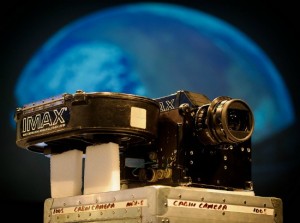The Space Shuttle’s IMAX Cameras Touch Down at Air and Space
The IMAX cameras used to capture dozens of NASA missions are now part of the Air and Space Museum’s collections
/https://tf-cmsv2-smithsonianmag-media.s3.amazonaws.com/filer/20120411113008imax-small.jpg)
Starting in 1984, NASA’s space shuttle missions carried a device that visually captured space travel like never before. The IMAX camera provided sweeping, immersive views of Earth and intimate windows into the minutae of astronauts’ lives in zero gravity. The footage, collected over 17 missions, produced six movies, such as The Dream is Alive and Blue Planet—films that brought moviegoers as close as possible to the experience of what it’s actually like to orbit in space.
Now, with the shuttle program retired after two decades of service, two of the IMAX cameras come to their final destination: the Air and Space Museum, where the idea for filming space with IMAX technology originated in the first place.
“This building had barely opened in 1976 when our first director, Apollo 11 astronaut Michael Collins, had an idea,” said space shuttle curator Valerie Neal. “He proposed to NASA that an IMAX motion picture camera be taken into space aboard one of the early space shuttle flights. Having been to space himself, and having been to the moon and back, he saw that the IMAX camera could bring that experience to far more people than would ever have the chance to go into space themselves.”

One of the IMAX cameras used on the space shuttle missions, now part of the Air and Space Museum's collections. Photo courtesy of NASA/Paul E. Alers
Thirty-six years later, IMAX co-inventor Graeme Ferguson and museum Associate Director Peter Jakab presided over the donation of two of the cameras used aboard the shuttle to the museum last week. The battered black camera on display during the ceremony, which weighs about 80 pounds, made a number of journeys into space, documenting missions all the way up 1998. ”This is a marvelous acquisition for the Air and Space Museum,” Jakab said. “It’s an object that represents the merging of the creative arts with technology—which is the mission of the Smithsonian, the mission of NASA, and the mission of IMAX. It’s an object that allows us to tell a great many stories.”
To understand just how richly these stories can be told with IMAX technology, you really have to sit in front of the museum’s five-story-high IMAX screen and absorb the immense scale of outer space. Seeing a film produced with this camera is entirely different from seeing movies about space travel, or watching on a TV. The screen almost entirely fills your field of vision, so the astronaut’s views become your views, and the entire surface pops with vivid detail.
This is enabled by the cameras’ ability to take in an incredible amount of visual information, shooting film with oversized, 70 mm frames—providing more than eight times the area of traditional 35 mm film. “We focused on two things when designing the camera. The first was that it was a very large format, so it could gather a great deal of information. If it were digital, you’d say it had a lot of megapixels,” Ferguson said. “The other thing we worked very hard at was making it small, because with this format, in which a frame is about three inches wide, if you just scaled up a normal movie camera it would be enormous.”
Astronauts underwent extensive training to use the cameras, since they had been designed to be used only by expert filmmakers. “In some respects, it was an extremely primitive camera,” said Ferguson. “It had no mirror reflex—which movie cameras have had since the 30s—it had no zoom, it had no autofocus, or autoexposure, which every point-and-shoot camera like now has. It was probably the least user-friendly piece of machinery that ever went into space.”
The cameras were minimally altered for flight, with bumpers added to the sharp corners to prevent injuries. But using them was still an ordeal for astronauts: the film had to be re-loaded after every three minutes of filming and extra lighting was required to produce attractive footage.
Still, Ferguson says, astronauts were interested in getting a chance to use the camera from the very start. “They would come up to me and say, ‘Is there any chance of getting IMAX on my flight?” Ferguson says. “That really shows the power that The Dream Is Alive had in conveying the stories that the astronauts wanted to tell.”
Both of the cameras first flew aboard Space Shuttle Discovery. The in-cabin camera will go on display in the museum’s “Moving Beyond Earth” gallery this summer. The payload-bay IMAX camera may go on display at the Steven F. Udvar-Hazy Center in the future, alongside the Space Shuttle Discovery, which will be welcomed into the collection on April 19.
/https://tf-cmsv2-smithsonianmag-media.s3.amazonaws.com/accounts/headshot/joseph-stromberg-240.jpg)
/https://tf-cmsv2-smithsonianmag-media.s3.amazonaws.com/accounts/headshot/joseph-stromberg-240.jpg)